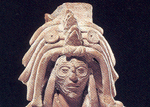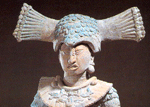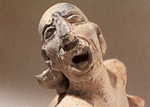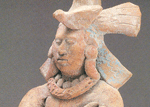
2.

3.

4.

5.
Mayan Art |
 2. |
 3. |
 4. |
 5. |
||
|---|---|---|---|---|---|
These representative images of Mayan art cover a period from 700 to 1500. However, Mayan art spans a period from 1500 BCE to the present. It developed out of influences from the Olmec civilization on the Mexican Gulf coast, the great and mysterious civilization of Teotihuacan (pyramid of the Sun near Mexico City), and the Toltecs. Mayan artistic expression in stone, pottery, murals, jade, obsidian, stucco, and codices is one of the richest artistic expressions in human history. Much—but not all—of Mayan art was religious or spiritual (i.e., ritual objects or images about their gods or the cosmos). Since many objects have been found in burial sites, many pieces are funerary or ritual objects. Much of Mayan art, also, was historical (about rulers and heroes). Not a few art objects, too, were about simply about regular human figures in daily life. In this regard, you will see not a little detailed realism in addition to stylized images. It is amazing to realize, when you study these images, that the Mayas did not have metal tools or the potter's wheel, not to mention the wheel itself. You will also see an example of the beautiful Maya pictographic writing or script, which, by the way, has been deciphered in recent years. Important note: These pages about Mayan art focus on their art from their pre-Columbian period. However, while their ancient civilization was "conquered", it did not disappear. On the contrary, Mayan art, music, culture, religion, and society still exist. There are roughly 10,000,000 native speakers of various Mayan dialects (or languages) who still live where they have always lived, in the lower reaches of Mesoamerica. |
|---|